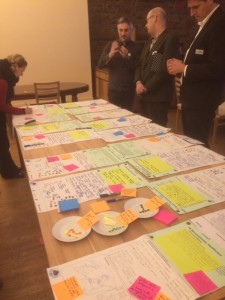Now that Ayn Rand’s ’the Fountainhead’ is put on stage by ‘Toneelgroep Amsterdam‘ I started re-reading some of its chapters/dialoges, after having first read it long ago. Once again I find it stunning, in the sense that much of what Rand wrote in 1947 is still valid and maybe more valid then in her days. One example:
“A building is alive, like a man. Its integrity follows its own truth, its only single theme, and to serve its only purpose. A man doesn’t borrow pieces of his body. A building doesn’t borrow hunks of its soul. Its maker gives it the soul and every wall, window and stairway to express it.” (p.16)
Of course; one can see/listen again to Roark’s famous fountainhead – roarks defense. he provides when he is in court, after being – correctly – accused of demolishing one of his (though build by another) buildings. Still; also after heaving seen/listened to Ramsey Nasr recently about his role: an architect has a client, a framework within which he builds. The Fountainhead is about holding on to one’s ideas and principles: but, referring to Nasr’s remarks, architecture is not ‘free art’ but does have its limits.
Nevertheless: after almost 70 years it remains fascinating, contemporary reading; without having seen it on stage yet, it is remarkable that it is practically sold out. I do hope not all visitors will be architects.
 January 31st.; the FET-Observe workshop in Brussels, organized and guided by Philine Warnke and Elna Schirrmeister from Fraunhofer Institute. Some 20 researchers from e.g. computing, art, media, design discussed a series of possible/wishful future technologies within a wide range of topics, including ‘Future Living Spaces’, with the aim to frame topics that need further focused research and funding. Wonderful to experience a critical but constructive discussion from a variety of disciplines as well as a somewhat out-of-line thinking against many current developments.
January 31st.; the FET-Observe workshop in Brussels, organized and guided by Philine Warnke and Elna Schirrmeister from Fraunhofer Institute. Some 20 researchers from e.g. computing, art, media, design discussed a series of possible/wishful future technologies within a wide range of topics, including ‘Future Living Spaces’, with the aim to frame topics that need further focused research and funding. Wonderful to experience a critical but constructive discussion from a variety of disciplines as well as a somewhat out-of-line thinking against many current developments.
